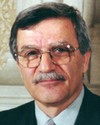moved:
That, in the opinion of this House, the government should: ( a ) recognize as genocide the killing of 1.5 million innocent Armenian men, women and children in the period 1915 to 1923; ( b ) condemn the genocide of the Armenians and all other acts of genocide as the ultimate act of religious, racial and cultural intolerance; ( c ) recognize the importance of remembering and learning from the mistakes of history; and ( d ) follow the recommendations of the Third Report of the Standing Committee on Canadian Heritage, in the Second session of the 36th Parliament, regarding the establishment, within one year, of a research facility on genocide.
Mr. Speaker, first I would like to acknowledge the members of the Canadian Armenian community sitting in the gallery, members of the Armenian Cultural Association of Ottawa, His Excellency the Ambassador of the Republic of Armenia and of course His Excellency the Ambassador of the Republic of Turkey. This is not the first time these two ambassadors have come together. On May 28, when we had the independence day celebration, the ambassador of Turkey certainly was a celebrity in the crowd of Armenians. I congratulate him for attending the reception along with the Armenian ambassador.
Before I go further in explaining my motion, I would like to give a historical background of the Armenian nation. Armenians have over 3,000 years of recorded history. As a matter of fact, on May 16, in room 200 of the parliament buildings, the Armenian community celebrated the 1,700th anniversary of Christianity by Canada Post issuing a stamp commemorating that fantastic event.
In the last 2,000 years or so Armenians have had four kingdoms. The last king died in Paris when he went to Europe seeking the help of Christian Europe, so to speak, for the defence of Armenian rights in Asia Minor. Soon after that Armenians lost their independence of their kingdom in a region called Al-Ladhiqiyah, which is located on the northeast corner of the Mediterranean Sea. From the 13th century to the 19th century Armenians had a good relationship, on and off, with their neighbours and communities.
However, in the early 1800s many Armenian intellectuals went to Europe to study and educate themselves further. They went back to Armenia at the end of the Ottoman Empire and asked for the same rights for their fellow Armenians in the region that they had had in Europe. The Red Sultan saw this as a threat. As a result of the activities of the Armenians who were demanding human rights, the Red Sultan decided to initiate the first major massacre of the 19th century, which occurred in 1895 and 1896.
That was followed, in the early stages of World War I in 1915, by what was known as the final solution by the party in Turkey at the time. I should point out that this was before Ataturk came to power in the early 1920s. As a result of the arrest of a group of intellectuals on April 24, 1915, Armenians were deported from their homeland. They were murdered and slaughtered. We acknowledge their murder and slaughter but we do not characterize it as genocide.
In Syria, in the Middle East, there is a town called Deir ez-Zour. Deir ez-Zour is the Auschwitz of the Armenian nation. Everyone knows about Auschwitz, but few people know about Deir ez-Zour, and fewer people yet have been to Deir ez-Zour to see the ruins and the remains of the Armenian nations as they were in 1915 to 1923.
The turning point for Armenian genocide was in 1965, the 50th anniversary of the genocide. At that time, despite the fact that Armenia was part of the U.S.S.R., the Armenian government was brave enough to establish the first genocide memorial in the world. That focused the attention of everyone in the world, especially the Armenians living in Armenia. They go there every year on April 24 to pay their respects to the victims of genocide.
The year 1965 also happened to be a turning point in the diaspora for genocide activities to make sure they were recognized by the world community.
In this country in 1980 the Ontario and Quebec parliaments passed resolutions recognizing the genocide and asked the federal government to follow suit and recognize genocide. I am glad to say I have been involved with this activity since 1965, that is, for the last 35 years. So far our activities have been fruitless in this parliament and other parliaments around the world, but I have to admit that Armenians throughout the world are making progress.
A few years ago a United Nations committee recognized the genocide and what happened to the Armenians. International bodies recognized that what happened to Armenians was genocide. The latest parliament to recognize the Armenian genocide was Italy's. However, the most important thing at this stage is this: I want to acknowledge the national assembly of France, both its lower and upper houses, and the president of France, Mr. Chirac, for France's recognition of the genocide of 1915 and for passing a law. As I understand it, people cannot deny the genocide, just as the Holocaust cannot be denied. People who do can be charged with misrepresenting history.
At this point I would like to ask for the unanimous consent of the House to table documents from the French national assembly, the Zorian Institute and the Armenian World Alliance.

